Yalukit Willam Nature Association

March 2023 Newsletter
Wygabil-ny-ewin, Old Man Sun Season on Boonwurrung Country
Magpie Goose sitting on a log at the Yalukit Willam Nature Reserve Photo by Danny Fog


Wygabil-ny-ewin, Old Man Sun Season on Boonwurrung Country
Magpie Goose sitting on a log at the Yalukit Willam Nature Reserve Photo by Danny Fog
Short finned eels (iilk in Boonwurrung) have been spotted in the canal recently, perhaps readying for the long migration to their breeding grounds deep in the Western Coral Sea somewhere.
You can listen here to Aunty Faye StewartMuir share the Boonwurrung story told by N’arwee’t Carolyn Briggs. The storytelling underscores the vastly changed landscape of Boonwurrung Country in Bayside with the rhythms of animals still following ancient pathways through and under our streets.


The recent return of Magpie Geese to visit the Yalukit Willam Nature Reserve is further evidence of the incredible memory animals have for Country, matching First Nations tenacious and continuous threads of Culture.
Thanks to a grant from the Palais we will be capturing many oral stories about people and their connection to the reserve and sharing them with you over the next months.
The Yalukit Willam Nature Association has had a hugely busy season and this time of the Iilk (Old Man Sun) has been a time of propagation, seed collecting, cleaning and planting in the Plant Lab and SPA (Seed Production Area). In 2023 YWNA has run multiple bird surveys, Fly by Nights (Invertebrate surveys), Working Bees and Waterwatch programs, keeping an eye on the health of the waterways and the life within it.
Boonwurrung people, in partnership with City of Port Phillip hosted the fourth annual We-Akon Dilinja (Mourning Reflection) dawn ceremony on Thursday 26 January 2023 at Alfred Sqaure, St Kilda. Honouring the past and realising a new united vision for our shared future We-Akon Dilinja - a commemorative dawn service honouring the past and realising a new united vision from the perspective of First Nations performers and speakers - is in its fourth year. This year's ceremony is themed Honouring the past and realising a new united vision for our shared future.
Alison VP interviewing long standing YWNA committee member Geoff Love for the oral history project. We-AkonDilinja Natalie Davey, YWNA PresidentWe are thrilled to share that YWNA has been awarded an Outstanding Service Award for their contribution to Waterwatch. One of three groups singled out from across the State. We will share more about this soon. The award recognises the long standing actions of everyone involved in water quality and macro-invertebrate monitoring and the role this has played in helping argue for the reserve and its management.
This group was originally set up through one of YWNA’s affiliates Friends of Elster Creek and some familiar names were involved in this. To name a few Kate Bulling, Gio Fitzpatrick and Jill Sokol played key roles. Kate Bulling handed the co-ordinator role over to me in 2019, just before the pandemic struck.
YWNA has been active with tours and developing education programs. We are fortunate to be able to work closely with affiliates like the Ecocentre, who are helping us to develop volunteer resources as well as running their own programs in the reserve.


We have many ideas in development and are hoping to be able to resource ourselves well to match the growing interest and enthusiasm people have for learning more about this unique and transforming space
 Reeds in the reserve
Winnowed seeds
YWNA Waterwatch 2023
Reeds in the reserve
Winnowed seeds
YWNA Waterwatch 2023
FriendsofNativeWildlifeBaysiderecently tookatourthroughthereservewiththeirbat detectorswhichcomplementsYWNAdesires tokeepasteadypaceofmonitoring programs.


Asamemberyouarewelcometoengagein alltheYWNAactivities,orsuggestsome ideasforengagement.Pleasekeepaneye onourwebsiteeventspageor/and Facebookpageforupcomingsurveysor workingbees.

Ourincreaseinprogrammingandthe upsurgeofinterestinthereserveisareason ourcommitteeisonthelookoutforany keenmembersinterestedinvolunteering sometimetohelpwithourcommunications team.Ifyouareinterestedpleaseemail YWNAatcommittee@elsternwickpark.org
Thanksasalwaystoallourkeenvolunteers andsupporters.Youareallamazing.
ToparaphraseDoraandthinkingaboutthe eels-justkeepswimming!!
Multicultural Bay Ambassadors from the EcoCentre with Plant Lab coordinator Claire Hudson Volunteers in the reserve Propagation at the Plant LabPinky the Pink-eared duck flew into the chain of ponds on the 29th of January much to the delight of many.
It stayed, moving back and forth from the creek pond to largest of the chain of ponds for about 2 weeks.
A few facts.. The Pink-eared Duck is found throughout Australia, it feeds in shallow warmish waters.


The highly specialised bill is fringed with fine lamellae (grooves) to filter out the microscopic plants and animals which make up the bulk of its diet.
Given its pink ear had not quite developed it was thought to be a juvenile. The previous sighting (I believe) was back in 2015 when Gio saw a pair.
Photos by Danny FogIf a tree falls in the forest and no one is around to hear it, does it make a sound?
Answer: Yes
If a bird’s song is snuffed out before you get a chance to know it, has something been lost?
Answer: Yes
Should we be doing all we can to allow its recovery?
Answer: Yes
When was the last time you shared space with a Superb Fairy-wren? Heard their rapid twittering and trilling, witnessed their unique social antics or saw the cyan on jet black of the breeding males that helped earn their description as ‘superb’? This is probably Australia’s best studied bird species and has also been voted Australia’s favourite bird, but Superb Fairy-wrens are waning as a presence in people’s daily lives. In my home city of Melbourne, they no longer nest in people’s gardens and haven’t done so for decades. This once friendly, familiar bird and “the favourite of the children” is becoming less and less recognisable for every generation. They, like so much else, are slipping into oblivion.
For those who grew up exploring the natural world in their home landscape, the community of living things, with which we share space, matters beyond ecosystem services or threatened species legislation. It’s everything. It’s the richness of life. It’s the unknowable, surprising and the strange; along with the familiar, comforting and cyclical. It’s the world outside and that within. It is the real world and perhaps humanity’s only company in the universe! Importantly, the destruction of all this is neither necessary nor inevitable. Much of it is the result of unconscious, not ill-intended, management and therein lies a great deal of hope for the power of information. The wildlife that survives alongside us in our home environments can inspire exploration, action and a sense of belonging in people.
Superb Fairy-wrens – as with all wildlife – are their own best ambassadors, but without interaction of course, a relationship can scarcely be built. If they can be brought back into people’s everyday lives through community action, a snowball-effect will hopefully ensue. Although Superb Fairy-wrens are just one piece of a whole collapsing ecosystem, they may be better placed than any other creature to guide the rescue mission for much of the rest. They have the power to spark a much-needed rethink of our gardens, parks and pavements. Indeed, they could improve our city as a whole. Let’s listen to what they have to say...
 Superb fairy-wren - Ryan Barnaby
Superb fairy-wren - Ryan Barnaby
Birdwatcher and compositor for The Age newspaper, George Arthur Keartland, who thankfully took detailed notes on Melbourne’s birds in the late 19th century, once watched a pair of fairy-wrens nesting and raising chicks outside Parliament House. He described them as being ubiquitous; living in “nearly every hedge or patch of scrub around Melbourne”. What a beautiful vision… What a different world…
By the 1960’s/70’s, Superb Fairy-wrens had already declined substantially in Melbourne but were still common in some larger city parks, along the lower Yarra River and on the city’s outer fringe. Black Rock resident, birdwatcher and pioneering habitat-gardener, Barbara Salter was well acquainted with a resident pair in her garden during the 1960’s whom she knew as Button and Emily. She wrote “in the early Spring, this tiny, brilliant blue bird went skipping about the garden, carrying a bright golden flower in his beak and looking quite irresistible” and said that this pair “were so tame that they would hop over the feet of school children who came in large parties to see the birds – in fact, Button received a number of Christmas cards!”. Barbara lived adjacent to the Sandringham Golf Course which, at the time, hosted Eastern Yellow Robins, Yellow-rumped Thornbills and a great range of other birds, now absent from the area.

Fairy-wrens disappeared from Bayside’s golf courses around 1980. The last place that they survived anywhere inland in Bayside was the Bay Road Heathland Sanctuary, which despite being only about 2ha, apparently hosted 3-4 family groups into the mid-nineties. In fact, this was their last inland stronghold through the vast swath of south-east Melbourne between the Royal Botanic Gardens, Melbourne and the Mordialloc Creek (a distance of over 20km). Here too, they died. On the other side of Melbourne, they hung on into recent times in the Melbourne General Cemetery. Birdwatchers regularly reported them there into the early 2000s alongside Yellow-rumped Thornbills, which have undergone an even more complete disappearance locally and will prove far more difficult to recover.
 Superb fairy-wren -Andrew McCutcheon
Superb fairy-wrens; female left, male right - Danny Fogg
Superb fairy-wren -Andrew McCutcheon
Superb fairy-wrens; female left, male right - Danny Fogg
Fairy-wrens still live in the Royal Botanic Gardens today, but rather than animating the lawns and undergrowth everywhere, as they did before, they are now restricted in the areas that they use. The same is true for Royal Park, a 180ha area of green space; 90% of which is now uninhabited by Superb Fairywrens. Across the landscape of inner suburban Melbourne today, an absence of Superb Fairy-wrens is the general rule, with a light peppering of exceptions. The activity of contrasting ecological conditions in areas of absence with the select few places where fairy-wrens persist into the present day, offers insights into likely causes and solutions. The birds are already showing us what works and what doesn’t, now we must interpret the patterns and act swiftly to reverse the trajectory.
In inner suburban Melbourne, there are seventeen sites of persistence and in the north, these include:
. The grounds of the Melbourne Zoo
. Trin Warren Tam Boore/Whites Skink Habitat
. Parts of the lower Merri Creek
In the east:
. Royal Botanical Gardens
. Studley Park
. Glen Iris Park
In the south:
. The northern half of the Elwood Foreshore
. Much of Brighton’s foreshore
In the west:
. Westgate Park
. Perc White Reserve
. Stony Creek Backwash
. Lower reaches of the Moonee Ponds Creek
. Newport Lakes
. Newell’s Paddock
. Point Gellibrand
. Newport Nature Reserve
. Jawbone Flora and Fauna Reserve/Altona Coastal Park

Paradise for fairy-wrens at Cherry Lake, Altona. Note the fine-scale patchwork of very low vegetation/bare ground and high-quality refuge in the form of Tangled Lignumone of the very best structural refuge plants for fairywrens

Tangled Lignum, Duma florulenta growing in the reserve. Tangled Lignum is a prominent feature at Trin Warren Tam Boore.
Though disparate in many ways, these seventeen places share some rather uncommon commonalities, aside from of course, the persistence of Superb Fairy-wrens. In general terms of value for local wildlife, these places are exceptional. Together they only make up a tiny portion of the area of inner suburban Melbourne but support an enormous proportion of the fauna diversity in the region. For example, the above sites include the top three bird migration stepping-stones in the city (Trin Warren Tam Boore/Whites Skink Habitat, Jawbone Flora and Fauna Reserve/Altona Coastal Park and the northern portion of the Elwood Foreshore) and between them, host every indigenous reptile species still existing in the region (13 species in total).
One could say – its no surprise that the last fairy-wrens remain in the highest-quality sites and that these are also the last strongholds for other declining wildlife, but that would miss an important detail. There is no such thing as high-quality habitat in general. Assessments of habitat quality are really only meaningful when made in relation to a given species or guild (or even a certain life-stage of a given species or within a certain ecological context). Pristine, old-growth, wet forest is terrible habitat for a Coast Saltbush or a Stubble Quail and high-quality temperate grassland would be a death-trap for a Greater Glider or a Rough Tree Fern.
So why then, does good habitat for fairy-wrens seem to constitute good habitat for such a diverse range of wildlife which actually specialise in living in very different habitats to one another?

The fairy-wren’s requirements cut through questions of habitat-type or ecological vegetation class to instead focus on certain key and universal characteristics which we often lose sight of, even in dedicated restoration attempts. They hop around the cool watery world of Southern Water Skinks and Delicate Skinks under a canopy of giant River Red Gums but are equally happy fossicking through the hot, dry sands of the Brighton dunes with Bougainville’s Skinks and White’s Skinks. The thirteen indigenous reptiles left in inner Melbourne are each, to varying degrees, restricted to certain parts of an environmental spectrum. Superb Fairy-wrens on the other hand, can happily jump across almost the whole spectrum from freshwater wetlands to rocky cliffs, escarpments, forests, grasslands, woodlands, scrubs, heaths, salt marshes and once upon a time, the manicured gardens of parliament house.
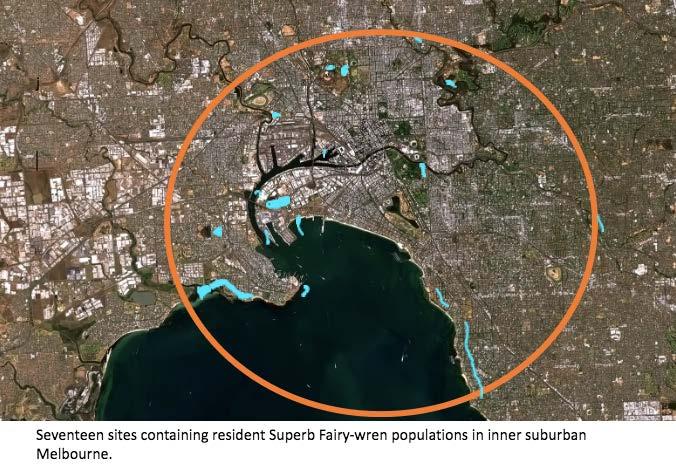 This site on the Brighton Foreshore offers passage to fairy-wrens but few foraging opportunities as ground-hugging woody vegetation directly abuts impervious surfaces.
This site on the Brighton Foreshore offers passage to fairy-wrens but few foraging opportunities as ground-hugging woody vegetation directly abuts impervious surfaces.
They could seem like the ultimate generalist but why then do we see them surviving in so few places and why do those places have such a high likelihood of hosting healthy populations of otherwise struggling wildlife? The fairy-wrens, don’t care that much about such fundamentals as floristics, overall vegetation type or even mesoclimate but, in a nutshell, appear need two things above all else; heterogeneity in the vegetation structure and productivity of insects. No wonder they are such a great indicator of habitatvalue across so many disparate habitats… Insects, of course, underpin virtually all terrestrial food webs as the greatest converters of plant material in animal tissue and heterogeneity in the vegetation structure largely drives species diversity.
When low and middle-story vegetation occurs without trees directly overhead or nearby, fairy-wrens are more willing to forage in the open; probably because there are fewer perches for aggressors such as Noisy Miners and predators such as Grey Butcherbirds and Collared Sparrowhawks. 'Understory' shouldn't be assumed to always imply that something is above.


The presence of water more or less enforces heterogeneity in the vegetation structure. Whether it be the transition from stunted trees, through shrubs and grasses to bare sand on a beach or the complexity of a riparian zone on a river; somewhere, sunlight will reach the ground-layer in abundance while dense vegetation provides cover nearby. This is the structurally complex mosaic that fairy-wrens and so many other organisms thrive in, but that our urban green spaces (including remnants and revegetation) so seldom offer.
Waterbodies themselves also tend to boost and diversify the food on offer for things like fairy-wrens. At Hampton they’ve been seen picking through freshly beach-cast seaweed - probably for amphipods and other crustaceans. The edges of wetlands are among the most productive environments in which to find invertebrates. For a bird which predominantly gleans its prey from surfaces, the clouds of Chironomid midges emanating from the water are probably not directly of much interest, but the dense populations of Long-jawed and Orb-weaving spiders which they support certainly would be.
The mown sections of Jim Willis Reserve provide productive foraging opportunities for the local Superb Fairywrens, as do the outer edges of the vegetation facing the bay. Jim Willis Reserve is the best site for small bush birds in the north of Bayside.Two introduced fishes which have devastated aquatic environments in our region – Mosquitofish and European Carp – should also be of interest to the fairy-wren restorationist. Although there are many examples of coexistence between one or both of these fishes and the bird, it stands to reason that there’d be a great deal more food on offer for a ground and foliage-gleaner if carp weren’t depriving aquatic ecosystems of light and plagues of Mosquitofish weren’t consuming most of the insect larvae before they can take flight.
So, even aquatic environments could be beneficiaries of the Superb Fairy-wren’s ambassadorial umbrella i.e. if wetlands were managed to control these fishes for the benefit of fairy-wrens, everything in the water from tadpoles to turtles and the entire submerged plant community will benefit.

The temptation to homogenise revegetation sites with trees all too often starves the ground-layer of light. There are several examples around the city of Superb Fairy-wrens thriving under powerlines which precluded the planting of trees, as seen here.




Julie Beatty is an Elwood local who became involved with the YWNR through her passion for litter. Julie can often be found walking the Elster creek with bag and tongs in hand, collecting rubbish out of the waterway and surrounds. Through conversations with people at the reserve she became involved in the Yalukit Willam Nature Association, and in September 2020 took on the role of co-president with Natalie Davey. During her year in that role, Julie’s knowledge of organisational structures and project management brought great insight to the YWNA committee. She stepped down from her role as co president but has remained an active volunteer, always offering a helping hand.
Julie has now taken on the job of organising the Plant Lab’s seed storage, including educating herself and sharing knowledge to others about seed collection, cleaning and storage. Throughout her involvement in the YWNA, the project has benefitted greatly from her constant enthusiasm and her ability to foster a sense of connection between people, which in turn builds a strong community.
Thanks for all your hard work over the years Julie!
Claire Hudson, Natalie Davey, Sandy Morrison, Zoe Daniel, Alison Soutar and Julie BeattyWe are thrilled to have Harry on board coordinating our working bees. Harry has been volunteering at the Plant Lab for over a year, always bringing a good attitude and some knowledge to share. Make sure to say hi and introduce yourself to Harry at the next working bee.
A big thanks to Adam Hosken, who coordinated the working bees from 2021 until recently. Adam shaped the working bee program, making them the special events that they are. We hope to see Adam behind the BBQ after a working bee sometime soon!

 Harry Baxter demonstrating propagation methods with Plant Lab coordinator Claire Hudson
Plants taking off in the Chain of Ponds
Harry Baxter demonstrating propagation methods with Plant Lab coordinator Claire Hudson
Plants taking off in the Chain of Ponds
The recent sighting of Spotless Crake and Australian Spotted Crake represent two new species for the reserve and not just any new species, but target species! The ecological requirements of these species helped to guide the design of the reserve. One of the major guiding requirements is the need for fluctuations in water level.
By a total accident, a blockage upstream of New Street is sending most of the creek’s flow down the Head St diversion which has dropped the water level in the creek’s wetland by approximately 15cm. This has created small areas of suitable habitat for certain muddy-edge specialists and sure enough, a Spotless Crake honed in on one such area.
The Spotted Crake has been using atypical habitat on Pond 4 and Soak 1, both of which are quite full and steep. The platforms of vegetation trampled down by foraging Purple Swamphens, have provided a proxy for exposed mud. It is exciting to think that if birds like this are turning up in suboptimal habitat and accidental habitat, what might be possible if we enact ephemeral hydrology in the Chain of Ponds…
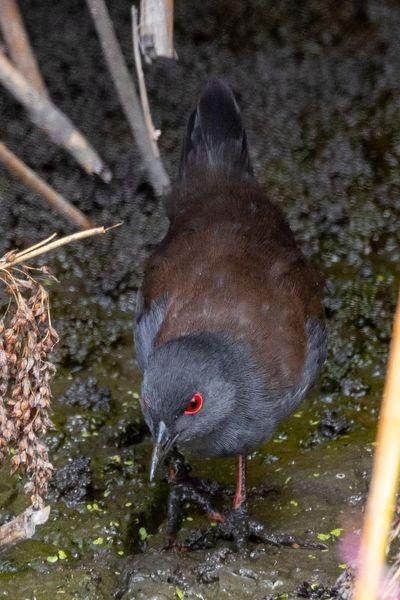
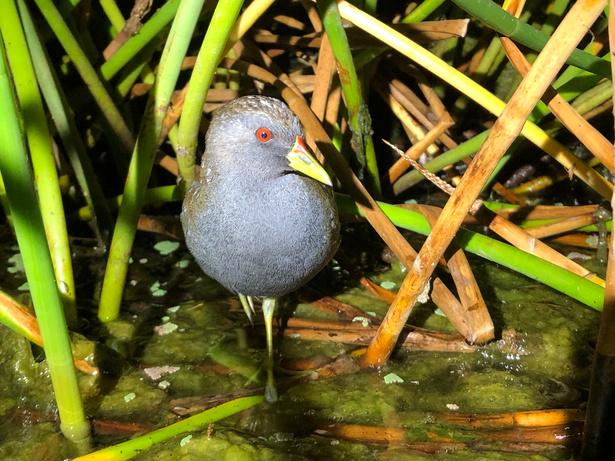 Australian Spotted Crake
Spotless Crake - photo by Margaret Alcorn
Australian Spotted Crake
Spotless Crake - photo by Margaret Alcorn
Thank you to all the volunteers who joined Clean Up Australia Day at the Yalukit Willam Nature Reserve. We were thrilled to have members from the Elsternwick football club join us to clean up the reserve (Go Wicks!).

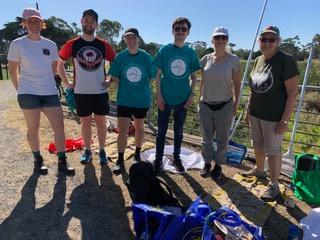
Together we collected and removed 17kg of rubbish. We also appreciate those who visit the YWNR and remove rubbish during their walks. If you are interested in joining us, our next get together is on Sunday 2nd April 2023 at 9.30am. Thanks so much everyone.

The Yalukit Willam Nature reserve iNaturalist project is a great resource showcasing the incredible biodiversity the reserve hosts.
Love Our Streets volunteers and members of the Elsternwick Football Club at a litter collection event
You can also contribute to citizen science and our knowledge of the YWNA by adding observations for identification by experts.
Hop on and have a look around here
Chain of Ponds - Natalie DaveyCheck out the events page on our website anytime for upcoming events at the YWNR
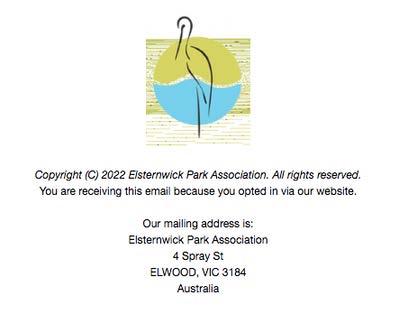
The Yalukit Willam Nature Association acknowledges the Yalukit Willam clan of the Boon Wurrung people - Traditional







Custodians of the Land and Sea Country we live on. We pay our respects to their Elders past and present. We celebrate the stories, cultures and traditions of Aboriginal and Torres Strait Elders of all communities.
